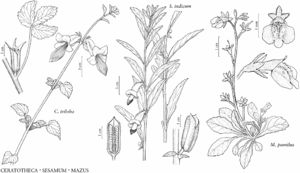Sesamum
Sp. Pl. 2: 634. 1753.
| Taxon | Illustrator ⠉ | |
|---|---|---|
 | Mazus pumilus Ceratotheca triloba Sesamum indicum | John Myers Barbara Alongi Barbara Alongi |
Annuals not foul smelling. Stems erect [prostrate], hairy [glabrous], hairs glandular and eglandular. Leaves opposite proximally, opposite or alternate distally. Inflorescences axillary, flowers solitary. Pedicels often with paired nectaries at base; bracteoles present or absent. Flowers: calyx tubular or cupulate, lobes linear to narrowly triangular; corolla white to pale-pink or pale-purple, often with darker veins proximally; staminode 1, filiform; style base persistent. Capsules not flattened, style base enlarged, forming a persistent beak, lateral horns absent. Seeds [10] 40–60 [–80], white, brown, or black, ovoid [obovoid], wings absent or present. x = 16.
Distribution
Introduced; Asia, Africa, tropical areas, also in South America, Europe, elsewhere in Asia, n Africa, Pacific Islands, Australia
Discussion
Species 21 (1 in the flora).